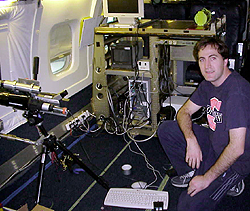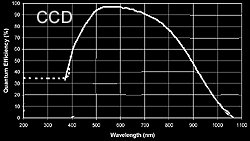|
SLIT - Fibre-optic fed slit-spectrograph
Instrument P.I.: Michael Winter, University of Stuttgart, Germany.
The information below will be updated as more precise data is received.
Technique: A high-resolution slit-spectrgraph which is fed by optical fiber attached to window assembly telescope.
Scientific objective: Resolve shock emissions in the near-UV.
 Instrument: The instrument consists of a computer controlled slit-spectrograph which is fed by an optical fiber and a small telescope assembly at the window. A co-aligned camera provides pointing capability, detecting stars to magnitude +7. The camera is an EM CCD Andor DU97 IN, back illuminated UV enhanced CCD, with 1600x400 pixels (16x16 micron) and 25.6 x 6.4 mm image area. The Spectrometer is an Acton Sp300i imaging spectrometer with 300 mm focal length F/D 4.5.
The telescope assembly focussing is performed with a 90 degree off-axis parabolic mirror of 50 mm diameter with a focal length of 100mm. The F/D~2 was chosen to meet the numerical aperture of the fibre optics yielding an angle of view of 0.45 degree.
A bundle of 50 quartz fibres of 100 Ám diameter are chosen. On the telescope side the fibres form a round cross section of 0.8 mm diameter, on the spectrometer side they are oriented in a row which can be used like a slit with a height of 5.6 mm and a width of 100 micron. If sufficient amounts of light are available, a slit can be used in addition to improve the spectral resolution.
Instrument: The instrument consists of a computer controlled slit-spectrograph which is fed by an optical fiber and a small telescope assembly at the window. A co-aligned camera provides pointing capability, detecting stars to magnitude +7. The camera is an EM CCD Andor DU97 IN, back illuminated UV enhanced CCD, with 1600x400 pixels (16x16 micron) and 25.6 x 6.4 mm image area. The Spectrometer is an Acton Sp300i imaging spectrometer with 300 mm focal length F/D 4.5.
The telescope assembly focussing is performed with a 90 degree off-axis parabolic mirror of 50 mm diameter with a focal length of 100mm. The F/D~2 was chosen to meet the numerical aperture of the fibre optics yielding an angle of view of 0.45 degree.
A bundle of 50 quartz fibres of 100 Ám diameter are chosen. On the telescope side the fibres form a round cross section of 0.8 mm diameter, on the spectrometer side they are oriented in a row which can be used like a slit with a height of 5.6 mm and a width of 100 micron. If sufficient amounts of light are available, a slit can be used in addition to improve the spectral resolution.
Heritage: The same telescope assembly was deployed during the 2002 Leonid MAC mission, feeding a rack-mounted slit-spectrograph.
Aircraft hardware requirements: Window swivel mount. Stow box. Rack mounted spectrometer and computer.
Instrument validation tests:
Sensitivity: The Electron multiplier gain is 1 - 1000 times, the pixel read out rate 0.05, 1, and 3 MHz.
Dynamic range:
Frame rate and exposure times: Maximum rate of spectra per second in full vertical binning mode: 328 up to 400 per second.
Spectral resolution - gives the FWHM of an instrument-broadened unresolved atomic spectral line:
A choice of spectral resolutions between 0.17 and 2.0 nm is available. Gratings of 50, 150, 300, 600, 1200, 1800, or 3600 l/mm are available, providing the following choice in resolution and wavelength coverage:
grating wavelength range pixel resolution FWHM FWHM
lines/mm nm nm nm Slit+F0 F0
300 300 490 0.3 0.7 2
600 300 245 0.15 0.4 1
1200 Hol. 120 0.077 0.2 0.5
1800 500 80 0.05 0.12 0.33
3600 hol.-UV 40 0.025 0.07 0.17
Relative spectral response - gives the wavelength dependence of the combined system (window, lens, spectrograph, and CCD camera) for each of the gratings given above:

wavelength: Quantum Efficiency:
(nm) (percentage)
1200 l/mm 300 l/mm 600 l/mm 1800 l/mm 3600 l/mm
200 72.0 31.3 80.0
225 85.3
250 78.7 60.0
300 61.3 75.7 60.0 20.9 48.0
350 50.7 39.1 52.5
400 40.0 60.0 47.5 54.8 49.3
450 32.0 57.4 45.1
500 24.0 44.3 37.5 75.7 41.4
550 21.3 65.2
600 20.0 30.0 27.8 58.7
700 22.2 20.0
800 17.0
900 14.3
|










 Instrument: The instrument consists of a computer controlled slit-spectrograph which is fed by an optical fiber and a small telescope assembly at the window. A co-aligned camera provides pointing capability, detecting stars to magnitude +7. The camera is an EM CCD Andor DU97 IN, back illuminated UV enhanced CCD, with 1600x400 pixels (16x16 micron) and 25.6 x 6.4 mm image area. The Spectrometer is an Acton Sp300i imaging spectrometer with 300 mm focal length F/D 4.5.
The telescope assembly focussing is performed with a 90 degree off-axis parabolic mirror of 50 mm diameter with a focal length of 100mm. The F/D~2 was chosen to meet the numerical aperture of the fibre optics yielding an angle of view of 0.45 degree.
A bundle of 50 quartz fibres of 100 Ám diameter are chosen. On the telescope side the fibres form a round cross section of 0.8 mm diameter, on the spectrometer side they are oriented in a row which can be used like a slit with a height of 5.6 mm and a width of 100 micron. If sufficient amounts of light are available, a slit can be used in addition to improve the spectral resolution.
Instrument: The instrument consists of a computer controlled slit-spectrograph which is fed by an optical fiber and a small telescope assembly at the window. A co-aligned camera provides pointing capability, detecting stars to magnitude +7. The camera is an EM CCD Andor DU97 IN, back illuminated UV enhanced CCD, with 1600x400 pixels (16x16 micron) and 25.6 x 6.4 mm image area. The Spectrometer is an Acton Sp300i imaging spectrometer with 300 mm focal length F/D 4.5.
The telescope assembly focussing is performed with a 90 degree off-axis parabolic mirror of 50 mm diameter with a focal length of 100mm. The F/D~2 was chosen to meet the numerical aperture of the fibre optics yielding an angle of view of 0.45 degree.
A bundle of 50 quartz fibres of 100 Ám diameter are chosen. On the telescope side the fibres form a round cross section of 0.8 mm diameter, on the spectrometer side they are oriented in a row which can be used like a slit with a height of 5.6 mm and a width of 100 micron. If sufficient amounts of light are available, a slit can be used in addition to improve the spectral resolution.
